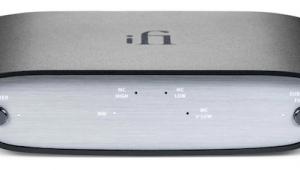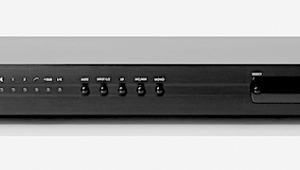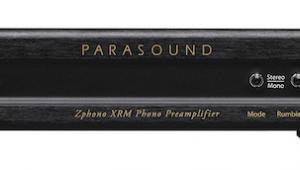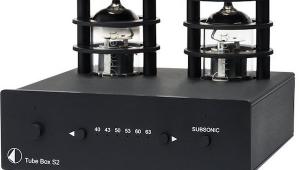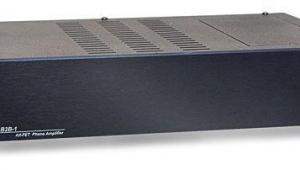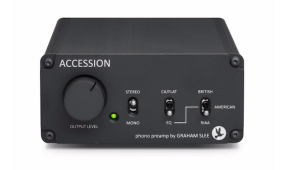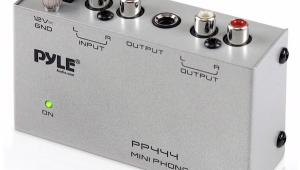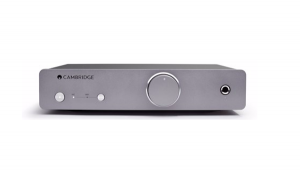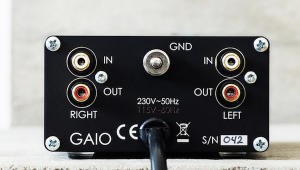Mikey, why do you have a meltdown whenever someone, who obviously does not have the knowledge you have, makes unqualified statements.
Graham Slee's $1449 Accession Raises the MM Playback Bar Page 2
I did most of the listening using the Sumiko Songbird high output moving coil cartridge referenced in the Pro-Ject DS2 USB review. Of course, it’s unfair to compare this $1449 dedication MM phono preamp to the DS2 USB but since it went into the system directly after the DS2, the comparison was inevitable and the differences were quite obvious.
The Accession’s superior dynamic slam, robust and taut bass response, transient “snap” and precision and overall transparency were immediately obvious as was its resolution of low level detail and especially its ability to resolve low level micro-dynamic detail that gives recorded music a “live” feel. Yet, it still had an overall sweet, full personality that MM fans like.
When I played “Fever” from the Analogue Productions’ double 45 reissue of Elvis is Back (AAPP-2231) I was seriously impressed by the power, depth and solidity of the bass line plus the “fleshy” texture of the finger snaps. Elvis’s rich high baritone was also reproduced convincingly and without any lower end congestion. I’m so used to the speed and resolution of my big rig, I’d forgotten how much listening pleasure can be derived from a richer sounding “full bodied” rig like this one.
I’m sorry I didn’t have a high output Soundsmith or Grado moving iron cartridge here to try with the Accession but I’m sure either would be a great match—not that the $899 Songbird wasn’t (review coming up).
But why not listen for yourself to the Songbird mounted on the Rega Planar 8 and driving the Accession? Through the generosity of Groove Note Records stream a 96/24 transfer of “Creep” from the just releasted AAA double 45rpm Limited Edition release of Vanessa Fernandez’s new album I Want You (Groove Note GRV 1200-1). Some fans loved her Led Zep tribute album When the Levee Breaks and some didn’t. This eclectic set in addition to a cover of Radiohead’s “Creep” includes everything from covers of Curtis Mayfield’s “Right On For the Darkness” to Marvin Gaye’s “I Want You” to Darryl Hall’s “Every Time You Go Away” popularized by Paul Young. But I thought you might enjoy Fernandez’s tortured X-rated (F-bomb warning) “Creep”. The sticker on the jacket says “No autotune used on this record” (LOL). Album review coming up!

Conclusion
As I was about to write this conclusion the postman delivered a new Electric Recording Company reissue of John Lee Hooker’s monophonic Riverside release The Country Blues of John Lee Hooker (ERC041/Riverside 12-838). I flipped the Accession’s “mono” switch and was treated to a transparent, focused, solid, well-textured holographic John Lee in my room coming out of a pitch black background. I don’t know what this record will sound like on the big rig, but this rendition was 100% satisfying.
The Accession is a versatile, superior sounding obsolete-proof MM phono preamp. If you’re listening to an accomplished MM or high output MC or MI, before trading cartridges, depending upon what you’re now using, you’d probably be stepping way up adding the well-balanced, transparent non-electronic sounding Accession to your system. Now for John Lee side two!
Accession Specs
Gain: 41.5dB
Input sensitivity range: 1.6mV to 7.2mV
Maximum input: 35mV
Maximum output: 5.2V rms
Input impedance: 47kOhms
Output impedance: 750 Ohms (fixed), 470 Ohms (variable-will drive 10k Ohms and above)
Noise at output: -66dB Quasi-peak 20Hz-20kHz
Distortion: typically 0.01% 20Hz-20kHz
RIAA accuracy: ±3dB
Frequency Response: <20Hz-45kHz (-3dB corrected to RIAA)
Channel Balance: 0.2dB
Channel Separation: 60dB
- Log in or register to post comments



"possible phono preamps to look at and decide on a purchase when ready", but:
1) volume knob makes no sense
2) Any time a manufacture makes ridiculous claims or screws up historical facts severely and puts it out there, etc. I automatically throw the piece into the BS snake oil bucket and take it to the dump.
I figure if one is going to make errant claims without checking or vetting and stick by them.....well, then something is wrong and caveat emptor.
I see no "melt-down" in what Michael wrote.
By the by, I didn't mind Vanessa Fernandez version of When The Levee Breaks or Kashmir, etc. I thought it was different and not bad or good, just different. My favorite version? No, still prefer the Led Zep version of Levee Breaks, but she did ok. She just offered up a different take on it, just as Led Zep did with their version.


Hi Mike,
I run a ShureV15V with Jico. Plan on sticking to MM's. How would you say this compares to the Era Gold or Reflex stages?


Hi,
I also have the same question. Have you got an answer?
It would be very interesting to know the differences between REFLEX M vs ACCESSION M
Thank you,

was due to a distinct lack of whirling or swishing.


A few minutes of research would've told you that GS actually holds a patent on the EQ method used in the phono stage. Perhaps if you read the patent you might understand the point of the phono stage. If not you could've cleared up any confusion with the manufacturer. There is also a separate MC-only model for LOMC users.


“Previously, pre-amplifiers treated the input signal as being homogenous—as if the record was outputting the frequency response FIG. 3C, which is today typically thought of as being the RIAA record output response. However, this is not in fact the case. Instead, as the inventor of the present application has appreciated, it should be thought of as the record response of FIG. 3B elevated by the rising response of the magnetic phono cartridge shown in FIG. 3A.”
Effectively it is saying that until this “invention” prior phono amplifiers just corrected the pick-up input for the RIAA curve, with its three “constants” but not the increase in cartridge output of 6dB/octave because of the nature of magnetic “derivative” or “velocity vs displacement” reading of the groove.
That cannot be correct, even the most basic phono amps correct for both. If I understood it right, in GS’s amp, these corrections are done by separate amplifier stages rather than in a single loop, but that is a choice a designer can make, it does not mean other designers ignored the 6dB/octave correction.



There is information and confusion in all of this and some of it has to do with industry parlance.
See, when audio engineers talk of “equalization” they only refer to what they add or subtract voluntarily and not to the extra they have to do because the magnetic medium requires it. Let me explain.
If you make a “flat” recording (on vinyl or tape, same thing), when a magnetic reader (a tape head or a magnetic cartridge) plays it back, the playback will have 6dB volume increase per octave. Why? Because magnetic devices cannot “read” the actual level of magnetism, they can only read its changing, or, in mathematical language, the “derivative” of the magnetic field. It just so happens that the derivative of a sine wave increases in amplitude with increasing frequency, exactly 6dB/octave at that. So a RIAA or any playback amp (NAB, CCIR, what have you) has to correct for this innate 6dB/octave rise.
What is called “equalization” is laid on top of this innate need for correction. Why? Because in analog recording there are limitations on what a piece of tape or vinyl will comfortably accommodate, compounded by where much of the recorded information resides. Over decades engineers have come up with compromises to accommodate these needs. Again, this has nothing to do with the 6dB/octave innate magnetic “derivative” rise, as Slee points out.
As a coda, non-magnetic and MR systems (piezo, optical, strain gage cartridges as well magnetoresistive tape playback heads used in hard drives and DCC and some later Technics cassette players) do not suffer the 6dB/octave rise so their equalization would be pure RIAA (or NAB, DIN, CCIR) without a need for “innate” magnetic correction.
This, I believe, has continued to confuse generations of audio enthusiasts.


The graph in the article makes recording and playback equalizations look like mirror images. They are not. The PB equalization has a much steeper downward slope, to compensate for the 6dB/octave magnetic pickup due to the amplitude increase from sine function’s derivative. I know in the “industry” they refer to these matters as “displacement” vs “velocity” but I find those expressions further complicate matters (like, displacement is the vector form [i.e., quantity + direction] of the scalar “distance” and “velocity’ of “speed” but no real need for any of those here as direction is not of any consequence for RIAA equalization).

and am using it with a Bob's Devices Sky 40 SUT. Outstanding combination, with some very expensive MC cartridges. By the way, Graham Slee also sells an MC version of the Accession, and an upgraded power supply is available, but it's not as good as the MM version plus SUT, in my experience.

and am in total agreement with the qualities that you mentioned Michael. I think this was a very positive review and, based on my own experience, a very accurate description of the Accession's virtues. Thanks Michael!

Thanks for another great review Michael. Anyone know of a US dealer for the MC version? I've googled, but can't find one. Thanks.

LP Gear in Las Vegas is listing the MC Accession on their website, partnered with the upgraded Enigma power supply. I highly recommend this PS for the MC version, it makes a major difference.

Highly recommend signing up as a member at the Graham Slee forums and taking advantage of their member discount. I bought an Accession last month - I saved a significant amount of money by using the 5% forum member code and buying direct...even with shipping the cost was something like 75% of what it would have been from a US dealer. I had it in my hands something like 10 days after ordering (that's accounting for build time as well as shipping). They also have a fantastic, free loaner/audition scheme.

It appears Mike may have misread the manual. Graham Slee gives an explanation on his forum. 9TA ceramic + Sp25 takes me down memory lane.
https://www.hifisystemcomponents.com/forum/correcting-michael-fremer_top...

I'm wondering if you have any recommendations for an MM cartridge that you feel would be a good match for the Accession. I bought one last month - and love it, dearly - and it's almost new cartridge time.

is so flexible and capable it will match any cartridge. Fellow owners that I've seen post their equipment have listed a great variety of cartridges and everyone seems, like me, thrilled with the results.

I upgraded from the Graham Slee Era Gold to the MM Accession. I have a Dynavector 20XH2 high output MC cart. Why the upgrade? 1) I play alot of mono jazz records from the 50s and wanted the mono switch. 2) I rip all my vinyl to the cloud. I don't think I saw it in the review, but there are 2 sets of outputs. I send 1 directly to my amp and the other into my laptop for recording.

I am seriously looking at buying this preamp for my secondary system. I’m currently using a Graham Slee 2se with a 24v sBooster external power supply. I was also looking at possibly digitizing some of my LPs as well. What would you recommend to use in between.


Michael, you often make a point that one should get a MM preamp if that is the type of cartridge being used. I see the point completely, since otherwise you are paying for all of the extra work/materials to make a high quality MC stage. But suppose one could get a Parasound JC3 for the same price as an Accession, would you suggest the Graham Slee or the Parasound, even if only MM carts were being used?





